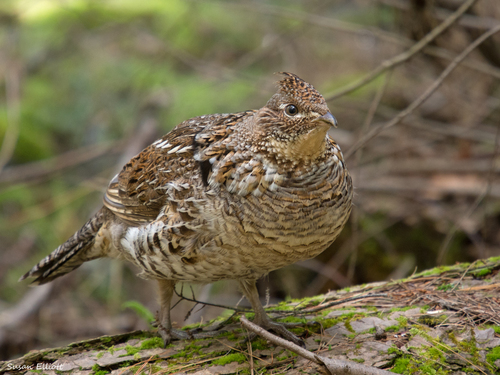
Ruffed Grouse
The Ruffed Grouse (Bonasa umbellus) is a medium-sized, non-migratory bird known for its cryptic plumage and distinctive drumming display. It plays a crucial role in the forest ecosystem as both prey for various predators and a seed disperser. This species is a popular game bird in North America, valued for its challenging hunt and flavorful meat. It holds a place in North American folklore, often symbolizing wilderness and the changing seasons.
40-50 cm
Length
50-64 cm
Wingspan
Least Concern
Conservation Status
Distribution
The Ruffed Grouse is found across North America, ranging from Alaska and Canada down through the Appalachian Mountains and parts of the Rocky Mountains. Its range extends as far south as northern Georgia in the east and into parts of the Pacific Northwest.
Lifespan
Typically 1-2 years in the wild, although some individuals can live up to 8 years. Captive birds may live longer.
Ruffed Grouse's Habitat
Habitat Types
Deciduous forests, Mixed forests, Coniferous forests, Areas with dense understory
Climate Zones
Temperate, Boreal
Adaptations
Ruffed Grouse have feathered nostrils and legs to help them withstand cold temperatures. They also develop small, fleshy projections called pectinations on their toes in winter, which act like snowshoes, providing better traction on snow and ice.
Variations
Numerous subspecies have been described, differing subtly in plumage coloration and size, reflecting adaptations to local environments. These variations are most noticeable in the tail band color, which can range from reddish-brown to gray.
Appearance
Breeding Plumage
Plumage is generally similar year-round, but males develop more prominent ruffs and brighter colors during the breeding season.
Seasonal Feather Changes
Minor seasonal variations, molting occurs after breeding season.
Sex Based Plumage Differences
Males have a larger, more conspicuous neck ruff and a black or dark brown tail band, while females have a smaller ruff and a typically lighter tail band, often broken or incomplete.
Notable Features
Prominent neck ruff (more pronounced in males), Cryptic, mottled brown and gray plumage, Short, strong legs, Fan-shaped tail with a subterminal band
Diet and Feeding
Primary Foods
Buds, Leaves, Fruits, Seeds, Insects (especially during summer and for chicks)
Foraging Behavior
Ruffed Grouse primarily forage on the ground, scratching and pecking at vegetation and insects. They also climb into shrubs and trees to feed on buds and catkins, especially in winter.
Specializations
They have a well-developed crop, allowing them to store food for later digestion. This is particularly useful in winter when food may be scarce or foraging time is limited.
Seasonal Diet Variations
Their diet shifts significantly with the seasons. In winter, they rely heavily on buds, twigs, and catkins of trees like aspen, birch, and willow. In spring and summer, they consume more leaves, fruits, and insects.
Behavior
Social Structure
Generally solitary except during breeding season and when females are raising young. They are not highly territorial, but males will defend their drumming logs.
Communication
Drumming (males), Clucking and other vocalizations (females and chicks), Visual displays (ruff and tail displays)
Migration
Ruffed Grouse are non-migratory, but they may make short-distance movements within their home range in response to food availability or weather conditions.
Territorial or Group Behaviors
Males defend drumming sites during breeding season. Outside of breeding season they are not highly territorial.
Conservation
Threats
Habitat loss and fragmentation (due to logging, development, and agriculture), Predation (by raptors, foxes, coyotes, and other predators), West Nile Virus
Protection Programs
Habitat management (e.g., creating young forest habitat), Hunting regulations
Local National Laws
Protected under various state and provincial wildlife regulations. Hunting seasons and bag limits are typically in place.
Population Trend
Stable overall, but with some regional declines.
Population Estimates
Difficult to estimate precisely due to their cryptic nature and habitat preferences, but considered relatively abundant across much of their range.
Interesting Facts
Ruffed Grouse can fly at speeds up to 40 mph.
Though, they're known for short bursts of flight.
The drumming sound produced by males is not made by hitting their wings against their chest or a log, but by the rapid movement of air created by their wings.
The sound can carry for up to a quarter-mile or more.
Ruffed Grouse chicks eat primarily Insects.
This provides the protein to grow.
Ruffed Grouse will sometimes bury themselves in the snow.
To stay warm during extremely cold weather.
Faqs about Ruffed Grouse
What is the difference between a Ruffed Grouse and a chicken?
While both are in the Phasianidae family, Ruffed Grouse are wild birds adapted to forest environments, while chickens are domesticated fowl.
Are Ruffed Grouse endangered?
No, they are classified as 'Least Concern' by the IUCN, although some local populations may be declining due to habitat loss.
Can you eat Ruffed Grouse?
Yes, Ruffed Grouse are a popular game bird and are considered to have flavorful meat. *Consult local hunting regulations before hunting.*
How long do Ruffed Grouse live for?
Typically 1-2 years in the wild.
Copyright @ Nature Style Limited. All Rights Reserved.
 English
English